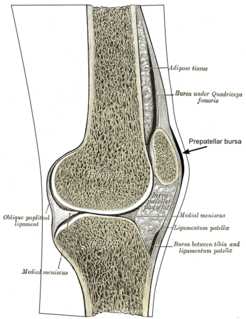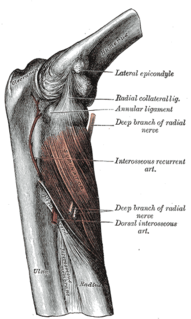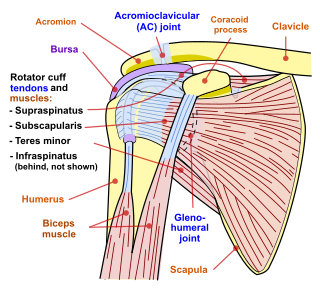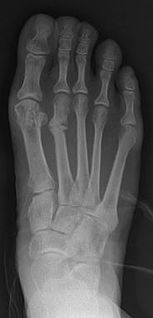 W
WAchilles tendinitis, also known as achilles tendinopathy, occurs when the Achilles tendon, found at the back of the ankle, becomes inflamed. The most common symptoms are pain and swelling around the affected tendon. The pain is typically worse at the start of exercise and decreases thereafter. Stiffness of the ankle may also be present. Onset is generally gradual.
 W
WChondromalacia patellae is an inflammation of the underside of the patella and softening of the cartilage.
 W
WChronic traumatic encephalopathy (CTE) is a neurodegenerative disease which causes severe and irreparable brain damage, as a result of repeated head injuries. Symptoms do not typically begin until years after the injuries and can include behavioral problems, mood problems, and problems with thinking. The disease often gets worse over time and can result in dementia. It is unclear if the risk of suicide is altered.
 W
WDe Quervain syndrome is inflammation of two tendons that control movement of the thumb and their tendon sheath. This results in pain at the outside of the wrist. Pain is typically increased with gripping or rotating the wrist. The thumb may also be difficult to move smoothly. Onset of symptoms is gradual.
 W
WDry eye syndrome (DES), also known as keratoconjunctivitis sicca (KCS), is the condition of having dry eyes. Other associated symptoms include irritation, redness, discharge, and easily fatigued eyes. Blurred vision may also occur. The symptoms can range from mild and occasional to severe and continuous. Scarring of the cornea may occur in some cases without treatment.
 W
WEmacs or EMACS is a family of text editors that are characterized by their extensibility. The manual for the most widely used variant, GNU Emacs, describes it as "the extensible, customizable, self-documenting, real-time display editor". Development of the first Emacs began in the mid-1970s, and work on its direct descendant, GNU Emacs, continues actively as of 2020.
 W
WGolfer's elbow, or medial epicondylitis, is tendinosis of the medial epicondyle on the inside of the elbow. It is in some ways similar to tennis elbow, which affects the outside at the lateral epicondyle.
 W
WIn occupational safety and health, hand arm vibrations (HAVs) are a specific type of occupational hazard which can lead to hand arm vibration syndrome.
 W
WIliotibial band syndrome (ITBS) is the second most common knee injury caused by inflammation located on the lateral aspect of the knee due to friction between the iliotibial band and the lateral epicondyle of the femur. Pain is felt most commonly on the lateral aspect of the knee and is most intensive at 30 degrees of knee flexion. Risk factors in women include increased hip adduction, knee internal rotation. Risk factors seen in men are increased hip internal rotation and knee adduction. ITB syndrome is most associated with long distance running, cycling, weight-lifting, and with military training.
 W
WInfrapatellar bursitis is inflammation of the superficial or deep infrapatellar bursa. Symptoms may include knee pain, swelling, and redness just below the kneecap. It may be complicated by patellar tendonitis.
 W
WLittle League elbow is a condition that is caused by repetitive throwing motions, especially in children who play sports that involve an overhand throw. "Little Leaguer's elbow" was coined by Brogdon and Crow in an eponymous 1960 article in the American Journal of Radiology.
 W
WInjuries to the arm, forearm or wrist area can lead to various nerve disorders. One such disorder is median nerve palsy. The median nerve controls the majority of the muscles in the forearm. It controls abduction of the thumb, flexion of hand at wrist, flexion of digital phalanx of the fingers, is the sensory nerve for the first three fingers, etc. Because of this major role of the median nerve, it is also called the eye of the hand. If the median nerve is damaged, the ability to abduct and oppose the thumb may be lost due to paralysis of the thenar muscles. Various other symptoms can occur which may be repaired through surgery and tendon transfers. Tendon transfers have been very successful in restoring motor function and improving functional outcomes in patients with median nerve palsy.
 W
WMusculoskeletal injury refers to damage of muscular or skeletal systems, which is usually due to a strenuous activity. In one study, roughly 25% of approximately 6300 adults received a musculoskeletal injury of some sort within 12 months—of which 83% were activity-related. Musculoskeletal injury spans into a large variety of medical specialties including orthopedic surgery, sports medicine, emergency medicine and rheumatology.
 W
WPatellar tendinitis, also known as jumper's knee, is an overuse injury of the tendon that straightens the knee. Symptoms include pain in the front of the knee. Typically the pain and tenderness is at the lower part of the kneecap, though the upper part may also be affected. Generally there is not pain when the person is at rest. Complications may include patellar tendon rupture.
 W
WPatellofemoral pain syndrome is knee pain as a result of problems between the kneecap and the femur. The pain is generally in the front of the knee and comes on gradually. Pain may worsen with sitting, excessive use, or climbing and descending stairs.
 W
WPlantar fasciitis is a disorder of the connective tissue which supports the arch of the foot. It results in pain in the heel and bottom of the foot that is usually most severe with the first steps of the day or following a period of rest. Pain is also frequently brought on by bending the foot and toes up towards the shin. The pain typically comes on gradually, and it affects both feet in about one-third of cases.
 W
WPrepatellar bursitis is an inflammation of the prepatellar bursa at the front of the knee. It is marked by swelling at the knee, which can be tender to the touch and which generally does not restrict the knee's range of motion. It can be extremely painful and disabling as long as the underlying condition persists.
 W
WRadial tunnel syndrome (RTS) is caused by increased pressure on the radial nerve as it travels from the upper arm to the hand and wrist.
 W
WA repetitive strain injury (RSI) is an injury to part of the musculoskeletal or nervous system caused by repetitive use, vibrations, compression or long periods in a fixed position. Other common names include repetitive stress disorders, cumulative trauma disorders (CTDs), and overuse syndrome.
 W
WA rotator cuff tear is an injury where one or more of the tendons or muscles of the rotator cuff of the shoulder get torn. Symptoms may include shoulder pain, which is often worse with movement, or weakness. This may limit people’s ability to brush their hair or put on clothing. Clicking may also occur with movement of the arm.
 W
WSesamoiditis is inflammation of the sesamoid bones.
 W
WA shin splint, also known as medial tibial stress syndrome, is pain along the inside edge of the shinbone (tibia) due to inflammation of tissue in the area. Generally this is between the middle of the lower leg to the ankle. The pain may be dull or sharp and is generally brought on by exercise. It generally resolves during periods of rest. Complications may include stress fractures.
 W
WShoulder problems including pain, are one of the more common reasons for physician visits for musculoskeletal symptoms. The shoulder is the most movable joint in the body. However, it is an unstable joint because of the range of motion allowed. This instability increases the likelihood of joint injury, often leading to a degenerative process in which tissues break down and no longer function well.
 W
WSnapping hip syndrome, also referred to as dancer's hip, is a medical condition characterized by a snapping sensation felt when the hip is flexed and extended. This may be accompanied by a snapping or popping noise and pain or discomfort. Pain often decreases with rest and diminished activity. Snapping hip syndrome is commonly classified by the location of the snapping as either extra- articular or intra-articular.
 W
WA Stener lesion is a type of traumatic injury to the thumb. It occurs when the aponeurosis of the adductor pollicis muscle becomes interposed between the ruptured ulnar collateral ligament (UCL) of the thumb and its site of insertion at the base of the proximal phalanx. No longer in contact with its insertion site, the UCL cannot spontaneously heal.
 W
WA stress fracture is a fatigue-induced fracture of the bone caused by repeated stress over time. Instead of resulting from a single severe impact, stress fractures are the result of accumulated trauma from repeated submaximal loading, such as running or jumping. Because of this mechanism, stress fractures are common overuse injuries in athletes.
 W
WTendinopathy, also known as tendinitis or tendonitis, is a type of tendon disorder that results in pain, swelling, and impaired function. The pain is typically worse with movement. It most commonly occurs around the shoulder, elbow, wrist, hip, knee, or ankle.
 W
WTennis elbow, also known as lateral epicondylitis, is a condition in which the outer part of the elbow becomes painful and tender. The pain may also extend into the back of the forearm and grip strength may be weak. Onset of symptoms is generally gradual. Golfer's elbow is a similar condition that affects the inside of the elbow.
 W
WGamekeeper's thumb is a type of injury to the ulnar collateral ligament (UCL) of the thumb. The UCL may be merely stretched, or it may be torn from its insertion site into the proximal phalanx of the thumb; in approximately 90% of cases part of the bone is actually avulsed from the joint. This condition is commonly observed among gamekeepers and Scottish fowl hunters, as well as athletes. It also occurs among people who sustain a fall onto an outstretched hand while holding a rod, frequently skiers grasping ski poles.
 W
WUlnar nerve entrapment is a condition where the ulnar nerve becomes physically trapped or pinched, resulting in pain, numbness, or weakness, primarily affecting the little finger and ring finger of the hand. Entrapment may occur at any point from the spine at cervical vertebra C7 to the wrist; the most common point of entrapment is in the elbow. Prevention is mostly through correct posture and avoiding repetitive or constant strain. Treatment is usually conservative, including medication, activity modification and exercise, but may sometimes include surgery. Prognosis is generally good, with mild to moderate symptoms often resolving spontaneously.
 W
WWorkrave is a free software application intended to prevent computer users from developing or aggravating occupational diseases such as carpal tunnel syndrome, repetitive strain injuries, or myopia.